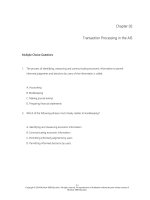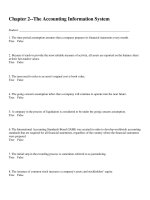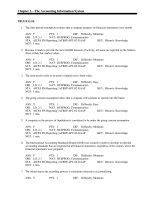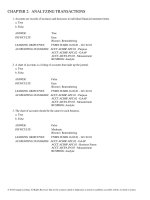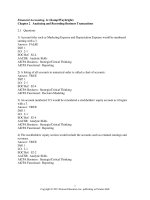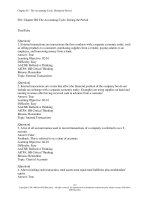Financial accounting 4th edition spiceland test bank
Bạn đang xem bản rút gọn của tài liệu. Xem và tải ngay bản đầy đủ của tài liệu tại đây (790.27 KB, 200 trang )
Chapter 02
The Accounting Cycle: During the Period
True / False Questions
1.
External transactions are transactions the firm conducts with a separate economic entity, such as
selling products to a customer, purchasing supplies from a vendor, paying salaries to an employee,
and borrowing money from a bank.
True
2.
False
Internal transactions are events that affect the financial position of the company but do not include
an exchange with a separate economic entity. Examples are using supplies on hand and earning
revenues after having received cash in advance from a customer.
True
3.
A list of all account names used to record transactions of a company is referred to as a T-account.
True
4.
False
After recording each transaction, total assets must equal total liabilities plus stockholders' equity.
True
5.
False
False
If a transaction causes total assets of the company to increase by $2,000, then liabilities plus
stockholders' equity also increases by $2,000.
True
False
2-1
Copyright © 2016 McGraw-Hill Education. All rights reserved. No reproduction or distribution without the prior written consent of
McGraw-Hill Education.
6.
If a transaction causes total assets of the company to increase by $5,000 and total liabilities to
increase by $3,000, then stockholders' equity increases by $8,000.
True
7.
Borrowing cash from the bank causes assets to increase and liabilities to increase.
True
8.
False
Purchasing equipment using cash causes assets to increase.
True
9.
False
False
Providing services to customers for cash causes stockholders' equity to increase.
True
False
10. Paying employees' salaries for the current month causes no change to stockholders' equity.
True
False
11. Paying dividends to its stockholders causes a company's stockholders' equity to decrease.
True
False
12. Selling common stock for cash causes assets to increase and stockholders' equity to decrease.
True
False
13. Purchasing office supplies on account causes assets to increase and liabilities to increase.
True
False
14. Providing services to customers on account causes assets to increase and stockholders' equity to
increase.
True
False
2-2
Copyright © 2016 McGraw-Hill Education. All rights reserved. No reproduction or distribution without the prior written consent of
McGraw-Hill Education.
15. Receiving cash in advance from a customer for services to be provided in the future causes assets
to increase and stockholders' equity to increase.
True
False
16. Paying for one year of rent in advance does not affect the accounting equation.
True
False
17. Purchasing supplies on account increases the balance of the Accounts Receivable account.
True
False
18. Amounts owed from customers are recorded in the Accounts Receivable account.
True
False
19. The two components of stockholders' equity are Debits and Credits.
True
False
20. Revenues have the effect of increasing retained earnings.
True
False
21. Expenses have the effect of decreasing retained earnings.
True
False
22. Receiving cash in advance from customers increases the Service Revenue account.
True
False
23. Deferred Revenue is a liability account.
True
False
2-3
Copyright © 2016 McGraw-Hill Education. All rights reserved. No reproduction or distribution without the prior written consent of
McGraw-Hill Education.
24. Liability accounts increase with a debit and decrease with a credit.
True
False
25. Liability accounts increase with a credit and decrease with a debit.
True
False
26. Common Stock increases with a credit and decreases with a debit.
True
False
27. Revenue accounts increase with a debit and decrease with a credit.
True
False
28. Expense accounts increase with a debit and decrease with a credit.
True
False
29. The Dividends account increases with a credit and decreases with a debit.
True
False
30. A debit to an account balance always results in the balance increasing.
True
False
31. A credit to an account balance always results in the balance decreasing.
True
False
32. A journal provides a chronological record of all transactions affecting a firm.
True
False
2-4
Copyright © 2016 McGraw-Hill Education. All rights reserved. No reproduction or distribution without the prior written consent of
McGraw-Hill Education.
33. For each transaction, there must be at least one debit amount and one credit amount.
True
False
34. For each transaction, the total debit amounts must equal the total credit amounts.
True
False
35. Selling common stock for cash is recorded with a debit to common stock.
True
False
36. Borrowing cash from the bank is recorded with a debit to cash.
True
False
37. Purchasing office supplies is recorded with a credit to office supplies.
True
False
38. Paying employees' salaries for the current period is recorded with a debit to Salaries Expense.
True
False
39. Providing services to customers is recorded with a debit to Service Revenue.
True
False
40. The general ledger includes all accounts used to record the company's transactions.
True
False
41. The process of transferring the debit and credit information from the journal to individual accounts
in the general ledger is called journalizing.
True
False
2-5
Copyright © 2016 McGraw-Hill Education. All rights reserved. No reproduction or distribution without the prior written consent of
McGraw-Hill Education.
42. After posting transactions to the general ledger accounts, the sum of the accounts with debit
balances should equal the sum of the accounts with credit balances.
True
False
43. A trial balance is a list of all accounts and their balances at a particular date, showing that assets
equal liabilities.
True
False
44. If total debits equal total credits in the trial balance, then all balances are correct.
True
False
Multiple Choice Questions
45. Which of the following is not part of measuring external transactions?
A. Using source documents to analyze accounts affected.
B. Recording transactions.
C. Making payments on all amounts owed.
D. Analyzing transactions for their effect on the accounting equation.
46. External events include all of the following except:
A. Paying rent.
B. Purchasing equipment.
C. Using office supplies.
D. Collecting an account receivable.
2-6
Copyright © 2016 McGraw-Hill Education. All rights reserved. No reproduction or distribution without the prior written consent of
McGraw-Hill Education.
47. The full set of procedures used to accomplish the measurement/communication process of
financial accounting is referred to as the:
A. Trial balance
B. Accounting cycle
C. Chart of accounts
D. General ledger
48. Which step in the process of measuring external transactions involves assessing the equality of
total debits and total credits for the period?
A. Use source documents to determine accounts affected by the transaction.
B. Prepare a trial balance.
C. Analyze the impact of the transaction on the accounting equation.
D. Post the transaction to the T-account in the general ledger.
49. A(n) _______________ summarizes all transactions related to a particular item over a period of time.
A. Debit
B. Account
C. Chart of accounts
D. Source document
50. A list of all account names used to record transactions of a company is referred to as the:
A. Chart of Accounts
B. Income statement
C. General journal
D. Balance sheet
2-7
Copyright © 2016 McGraw-Hill Education. All rights reserved. No reproduction or distribution without the prior written consent of
McGraw-Hill Education.
51. For each transaction recorded in an accounting system, the basic equation that must be
maintained at all times is:
A. Assets = Liabilities + Stockholders' Equity.
B. Cash Increases = Cash Decreases.
C. Revenues = Expenses + Dividends.
D. Assets = Liabilities.
52. The following amounts are reported in the ledger of Mariah Company:
Assets
$80,000
Liabilities
36,000
Retained Earnings
12,000
What is the balance in the Common Stock account?
A. $44,000.
B. $32,000.
C. $48,000.
D. $42,000.
53. When a company pays employees' salaries for the current period, how will the basic accounting
equation be affected?
A. Stockholders' equity decreases.
B. Revenues decrease.
C. Expenses decrease.
D. Liabilities decrease.
2-8
Copyright © 2016 McGraw-Hill Education. All rights reserved. No reproduction or distribution without the prior written consent of
McGraw-Hill Education.
54. When cash payments are made to stockholders, what is the effect on the company's accounts?
A. Cash decreases and dividends increase.
B. Cash increases and dividends decrease.
C. Cash decreases and common stock decreases.
D. Cash increases and common stock increases.
55. Receiving cash from customers before services are performed results in:
A. Prepaid Assets.
B. Service Revenue.
C. Deferred Revenues.
D. Accounts Receivable.
56. When the company pays stockholders a dividend, what is the effect on the accounting equation
for that company?
A. Decrease stockholders' equity and increase assets.
B. Increase liabilities and increase assets.
C. Decrease assets and decrease liabilities.
D. Decrease assets and decrease stockholders' equity.
57. Pumpkin Inc. sold $500 in pumpkins to a customer on account on January 1. On January 11
Pumpkin collected the cash from that customer. What is the impact on Pumpkin's accounting
equation from the collection of cash?
A. No net effect to the accounting equation.
B. Decrease assets and increase liabilities.
C. Increase assets and increase liabilities.
D. Decrease assets and decrease liabilities.
2-9
Copyright © 2016 McGraw-Hill Education. All rights reserved. No reproduction or distribution without the prior written consent of
McGraw-Hill Education.
58. A company receives a $50,000 cash deposit from a customer on October 15 but will not provide
services until November 20. Which of the following statements is true?
A. The company records service revenue on October 15.
B. The company records cash collection on November 20.
C. The company records deferred revenue on October 15.
D. The company records nothing on October 15.
59. Which of the following would increase assets and increase liabilities?
A. Provide services to customers on account.
B. Purchase office supplies on account.
C. Pay dividends to stockholders.
D. Receive a utility bill but do not pay it immediately.
60. Receiving cash from an account receivable:
A. Increases revenue and decreases an asset.
B. Decreases a liability and increases an asset.
C. Increases an asset and increases revenue.
D. Increases one asset and decreases another asset.
61. An expense has what effect on the accounting equation?
A. Decrease liabilities.
B. Decrease stockholders' equity.
C. Increase assets.
D. No effect.
2-10
Copyright © 2016 McGraw-Hill Education. All rights reserved. No reproduction or distribution without the prior written consent of
McGraw-Hill Education.
62. Revenues have what effect on the accounting equation?
A. Increase liabilities.
B. Decrease assets.
C. Increase stockholders' equity.
D. No effect.
63. Investments by stockholders have what effect on the accounting equation?
A. Assets increase and liabilities increase.
B. Expenses increase and liabilities increase.
C. Assets increase and revenues increase.
D. Assets increase and stockholders' equity increases.
64. Which of the following is not possible when recording a transaction?
A. Liabilities increase and assets decrease.
B. Stockholders' equity increases and assets increase.
C. One asset increases and another asset decreases.
D. Stockholders' equity decreases and assets decrease.
65. Purchasing office supplies on account will:
A. Not change assets.
B. Increase assets and decrease liabilities.
C. Increase assets and increase liabilities.
D. Increase assets and increase stockholders' equity.
2-11
Copyright © 2016 McGraw-Hill Education. All rights reserved. No reproduction or distribution without the prior written consent of
McGraw-Hill Education.
66. Providing services and receiving cash will:
A. Increase assets and increase stockholders' equity.
B. Increase assets and increase liabilities.
C. Decrease assets and increase liabilities.
D. Decrease liabilities and increase stockholders' equity.
67. When a company provides services on account, the accounting equation would be affected as
follows:
A. Assets increase.
B. Revenues increase.
C. Assets increase and liabilities decrease.
D. Assets increase and stockholders' equity increases.
68. If a company provides services on account, which of the following is true?
A. Expenses increase.
B. Liabilities increase.
C. Stockholders' equity increases.
D. Assets decrease.
69. When a payment is made on an account payable:
A. Assets and stockholders' equity decrease.
B. Assets and liabilities decrease.
C. Liabilities and revenues decrease.
D. Assets and expenses decrease.
2-12
Copyright © 2016 McGraw-Hill Education. All rights reserved. No reproduction or distribution without the prior written consent of
McGraw-Hill Education.
70. Purchasing office equipment on account has what impact on the accounting equation?
A. Stockholders' equity decreases and assets increase.
B. Liabilities increase and assets increase.
C. Assets decrease and liabilities decrease.
D. Assets increase and stockholders' equity increases.
71. Purchasing supplies for cash has what effect on the accounting equation?
A. Increase assets.
B. Decrease stockholders' equity.
C. Decrease liabilities.
D. No effect.
72. On January 1, Brad Inc. sold $30,000 in products to a customer on account. Then on January 10,
Brad collected the cash on that account. What is the impact on Brad's accounting equation from
the collection of cash on January 10?
A. No net effect on the accounting equation.
B. Assets increase and liabilities decrease.
C. Assets decrease and liabilities decrease.
D. Assets increase and stockholders' equity increases.
73. On September 30, MFP Co. paid employee salaries of $7,000, including $1,000 it owed to its
employees last month. What are the effects of this transaction on the accounting equation?
A. Expenses increased, liabilities increased, and assets increased.
B. Assets decreased, liabilities decreased, and expenses increased.
C. Assets decreased, expenses decreased, and liabilities increased.
D. Expenses decreased, liabilities decreased, and assets decreased.
E. Assets increased, expenses increased, and liabilities decreased.
2-13
Copyright © 2016 McGraw-Hill Education. All rights reserved. No reproduction or distribution without the prior written consent of
McGraw-Hill Education.
74. Following are transactions of Gotebo Tanners, Inc., a new company, during the month of January:
1. Issued 10,000 shares of common stock for $15,000 cash.
2. Purchased land for $12,000, signing a note payable for the full amount.
3. Purchased office equipment for $1,200 cash.
4. Received cash of $14,000 for services provided to customers during the month.
5. Purchased $300 of office supplies on account.
6. Paid employees $10,000 for their first month's salaries.
What was the total amount of Gotebo's liabilities following these six transactions?
A. $12,300.
B. $27,300.
C. $22,600.
D. $15,500.
75. Consider the following transactions:
Issued common stock for cash.
Purchased equipment by signing a note payable.
Paid rent for the current month.
Collected cash from customers on account.
How many of these four transactions increased the given company's total assets?
A. One.
B. Two.
C. Three.
D. Four.
2-14
Copyright © 2016 McGraw-Hill Education. All rights reserved. No reproduction or distribution without the prior written consent of
McGraw-Hill Education.
76. Assume that Sallisaw Sideboards, Inc. had a retained earnings balance of $10,000 on April 1, and
that the company had the following transactions during April.
Issued common stock for cash, $5,000.
Provided services to customers on account, $2,000.
Provided services to customers in exchange for cash, $900.
Purchased equipment and paid cash, $4,300.
Paid April rent, $800.
Paid employees' salaries for April, $700.
What was Sallisaw's retained earnings balance at the end of April?
A. $11,400.
B. $12,100.
C. $16,400.
D. Some other amount.
77. Consider the following transactions:
Issued common stock for cash.
Purchased equipment by signing a note payable.
Provided services to customers on account.
Collected cash from customers on account.
How many of these four transactions increased the given company's total liabilities?
A. One.
B. Two.
C. Three.
D. Four.
2-15
Copyright © 2016 McGraw-Hill Education. All rights reserved. No reproduction or distribution without the prior written consent of
McGraw-Hill Education.
78. Following are transactions of Gotebo Tanners, Inc., a new company, during the month of January:
1. Issued 10,000 shares of common stock for $15,000 cash.
2. Purchased land for $12,000, signing a note payable for the full amount.
3. Purchased office equipment for $1,200 cash.
4. Received cash of $14,000 for services provided to customers during the month.
5. Purchased $300 of office supplies on account.
6. Paid employees $10,000 for their first month's salaries.
How many of these transactions decreased Gotebo's total assets?
A. One.
B. Two.
C. Three.
D. Four.
79. Following are transactions of Gotebo Tanners, Inc., a new company, during the month of January:
1. Issued 10,000 shares of common stock for $15,000 cash.
2. Purchased land for $12,000, signing a note payable for the full amount.
3. Purchased office equipment for $1,200 cash.
4. Received cash of $14,000 for services provided to customers during the month.
5. Purchased $300 of office supplies on account.
6. Paid employees $10,000 for their first month's salaries.
How many of these transactions increased Gotebo's liabilities?
A. Four.
B. Three.
C. Two.
D. One.
2-16
Copyright © 2016 McGraw-Hill Education. All rights reserved. No reproduction or distribution without the prior written consent of
McGraw-Hill Education.
80. Which of the following transactions causes a decrease in stockholders' equity?
A. Pay dividends to stockholders.
B. Obtain cash by borrowing from a local bank.
C. Provide services to customers on account.
D. Purchase office equipment for cash.
81. How many of the following events would require an expense to be recorded?
Ordering office supplies
Hiring a receptionist
Paying employees' salaries for the current month
Receiving but not paying a current utility bill
Paying for insurance in advance
A. One.
B. Two.
C. Three.
D. Four.
82. Which of the following is NOT possible for a business transaction?
A. Increase assets and decrease revenue.
B. Decrease assets and increase expense.
C. Increase liabilities and increase expense.
D. Decrease liabilities and increase revenue.
2-17
Copyright © 2016 McGraw-Hill Education. All rights reserved. No reproduction or distribution without the prior written consent of
McGraw-Hill Education.
83. Which of the following transactions would cause a decrease in both assets and stockholders'
equity?
A. Paying insurance premium for the next two years.
B. Purchasing office equipment on account.
C. Paying advertising for the current month.
D. Providing installation services to customers.
84. When a company issues common stock for cash, what is the effect on the accounting equation for
the company?
A. Assets increase and liabilities increase.
B. Assets increase and stockholders' equity increases.
C. Assets decrease and liabilities decrease.
D. Liabilities decrease and stockholders' equity increases.
85. If the liabilities of a company increased by $55,000 during a month and the stockholders' equity
decreased by $21,000 during that same month, did assets increase or decrease and by how much?
A. $34,000 increase.
B. $55,000 increase.
C. $34,000 decrease.
D. $76,000 increase.
86. Which of the following transactions would cause an increase in both the assets and liabilities of a
company?
A. Paying for the current month's rent.
B. Pay for inventory purchased 90 days ago.
C. Purchase of a building by issuing a note payable.
D. Services received on account.
2-18
Copyright © 2016 McGraw-Hill Education. All rights reserved. No reproduction or distribution without the prior written consent of
McGraw-Hill Education.
87. When a company pays cash for equipment, what is the effect on the accounting equation for that
company?
A. Increase assets and increase liabilities.
B. Decrease assets and decrease liabilities.
C. No change.
D. Increase assets and increase stockholders' equity.
88. "Record revenue when goods or services are provided to customers" is the definition of which
principle in accounting?
A. Trial balance.
B. Debits and credits.
C. Revenue recognition.
D. Accounting equation.
89. Which of the following is possible for a particular business transaction?
A. Increase assets; Decrease liabilities
B. Decrease assets; Increase assets
C. Decrease assets; Increase stockholders' equity
D. Decrease liabilities; Increase expenses
90. Which of the accounts are decreased on the debit side and increased on the credit side?
A. Liabilities, stockholders' equity, and revenues.
B. Dividends, liabilities, and assets.
C. Expenses, dividends, and stockholders' equity.
D. Assets, dividends, and expenses.
2-19
Copyright © 2016 McGraw-Hill Education. All rights reserved. No reproduction or distribution without the prior written consent of
McGraw-Hill Education.
91. Which of the following is true about a "debit"?
I. It is part of the double-entry procedure that keeps the accounting equation in balance.
II. It represents an increase to assets.
III. It represents a decrease to liabilities.
IV. It is on the right side of a T-account.
A. I and II.
B. IV only.
C. I, II, and III.
D. I, II, III, and IV.
92. Which of the following is true about a "credit"?
I. It is part of the double-entry procedure that keeps the accounting equation in balance.
II. It represents a decrease to assets.
III. It represents an increase to liabilities.
IV. It is on the right side of a T-account.
A. I and II.
B. IV only.
C. I, II, and III.
D. I, II, III, and IV.
93. Assets normally carry a _______ balance and are shown in the ______________.
A. Debit; Statement of stockholders' equity
B. Debit; Income statement
C. Credit; Balance sheet
D. Debit; Balance sheet
2-20
Copyright © 2016 McGraw-Hill Education. All rights reserved. No reproduction or distribution without the prior written consent of
McGraw-Hill Education.
94. Revenues normally carry a _______ balance and are shown in the ______________.
A. Debit; Statement of stockholders' equity
B. Credit; Income statement
C. Credit; Balance sheet
D. Debit; Balance sheet
95. Dividends normally carry a _______ balance and are shown in the ______________.
A. Debit; Statement of stockholders' equity
B. Debit; Income statement
C. Credit; Balance sheet
D. Debit; Balance sheet
96. Expenses normally carry a _______ balance and are shown in the ______________.
A. Debit; Statement of stockholders' equity
B. Debit; Income statement
C. Credit; Balance sheet
D. Debit; Balance sheet
97. Liabilities normally carry a _______ balance and are shown in the ______________.
A. Debit; Statement of stockholders' equity
B. Debit; Income statement
C. Credit; Balance sheet
D. Debit; Balance sheet
2-21
Copyright © 2016 McGraw-Hill Education. All rights reserved. No reproduction or distribution without the prior written consent of
McGraw-Hill Education.
98. Which of the following accounts has a debit balance?
A. Accounts Payable.
B. Deferred Revenue.
C. Service Revenue.
D. Salaries Expense.
99. Which of the following accounts would normally have a credit balance?
A. Accounts Payable, Service Revenue, Common Stock.
B. Salaries Payable, Deferred Revenue, Delivery Expense.
C. Income Tax Payable, Service Revenue, Dividends.
D. Cash, Repairs and Maintenance Expense, Dividends.
100. Which of the following accounts would normally have a debit balance?
A. Accounts Payable, Service Revenue, Common Stock.
B. Salaries Payable, Deferred Revenue, Utilities Expense.
C. Income Tax Payable, Service Revenue, Dividends.
D. Cash, Delivery expense, Dividends.
101. Which of the following accounts would normally have a debit balance and appear in the balance
sheet?
A. Accounts Receivable.
B. Deferred Revenue.
C. Salaries Expense.
D. Dividends.
2-22
Copyright © 2016 McGraw-Hill Education. All rights reserved. No reproduction or distribution without the prior written consent of
McGraw-Hill Education.
102. Which of the following accounts has a credit balance?
A. Salaries Expense.
B. Income Tax Payable.
C. Land.
D. Prepaid Rent.
103. An increase to an asset account is shown with a ______________. An increase to a liability account is
shown with a ______________.
A. Debit; Debit
B. Credit; Debit
C. Debit; Credit
D. Credit; Credit
104. An increase to an expense account is shown with a ______________. An increase to a revenue
account is shown with a ______________.
A. Debit; Debit
B. Debit; Credit
C. Credit; Debit
D. Credit; Credit
105. An increase to an asset account is shown with a ______________. A decrease to an asset account is
shown with a ______________.
A. Debit; Debit
B. Credit; Debit
C. Debit; Credit
D. Credit; Credit
2-23
Copyright © 2016 McGraw-Hill Education. All rights reserved. No reproduction or distribution without the prior written consent of
McGraw-Hill Education.
106. Which of the accounts are increased with a debit and decreased with a credit?
A. Liabilities, stockholders' equity, and revenues.
B. Dividends, liabilities, and assets.
C. Expenses, dividends, and stockholders' equity.
D. Assets, dividends, and expenses.
107. Consider the following list of accounts:
Cash
Retained Earnings
Service Revenue
Utilities Expense
Salaries Expense
Accounts Receivable
Accounts Payable
Common Stock
Equipment
Dividends
How many of these accounts have a normal debit balance?
A. Four.
B. Five.
C. Six.
D. Seven.
2-24
Copyright © 2016 McGraw-Hill Education. All rights reserved. No reproduction or distribution without the prior written consent of
McGraw-Hill Education.
108. Consider the following list of accounts:
Accounts Payable
Cash
Prepaid Rent
Common Stock
Salaries Payable
Equipment
Supplies
Rent Expense
How many of these accounts have a normal credit balance?
A. Two.
B. Three.
C. Four.
D. Five.
109. Consider the following accounts:
Utilities Expense
Accounts Payable
Service Revenue
Common Stock
How many of these accounts are increased with debits?
A. One.
B. Two.
C. Three.
D. Four.
2-25
Copyright © 2016 McGraw-Hill Education. All rights reserved. No reproduction or distribution without the prior written consent of
McGraw-Hill Education.
